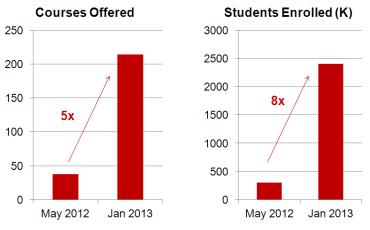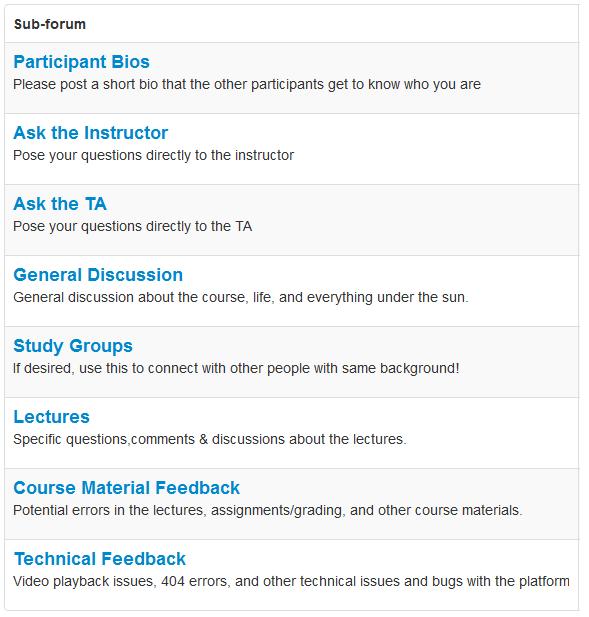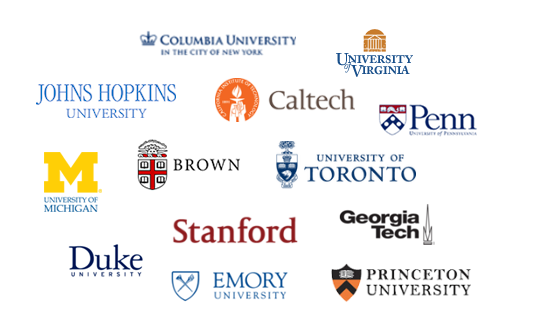Two months ago I didn’t know what a M-O-O-C was. Now, I am convinced it will be the juggernaut that disrupts higher education. For the last 20 years, traditional universities have only given lip-service to online education. They may have put out a few extension courses here and there, but they largely forfeited the medium to the likes of Kaplan and University of Phoenix – the publicly-traded, for-profit education companies.
New boldness. Where traditional universities were once timid, they are now bold. Call it a second lease on life, but now Harvard, Princeton, Stanford, and MIT are putting courses online for free. Peter Norvig, Director of Research at Google, and Sebastian Thurn, Director of Stanford’s Artificial Intelligence Lab, offered an engineering course that enrolled 160,000 students from 209 countries. See the TED talk here.

Three big MOOCs. The big three MOOCs are Udacity, Coursera, and EdX. As you can see below, they are all a bit different in structure, origin, and financial backing. That said, they all have access to premium content and a limitless distribution platform.

Ambitious vision. The MOOCs are here to educate students on a massive scale. From Coursera’s website, they describe their not-so-humble vision of future education:
We envision a future where the top universities are educating not only thousands of students, but millions. Our technology enables the best professors to teach tens or hundreds of thousands of students.
This is not hyperbole or unwarranted internet braggadocio. It’s hard to overstate how fast MOOCs are growing and how scalable this model is. Looking at the numbers for Coursera below, you can see that during the last 8 months, the number of courses grew from 33 to 214. Coursera’s student enrollment grew 800% to 2.4 million.

Less boring, more interactive. The New York Times notes that MOOCs have been around for a while, but they were largely “techie, online learning tools”. The platforms have matured enough to create a user-friendly, learning community. Taking a cue from Khan Academy, professor video segments are short. To keep people motivated, the videos are interspersed with quizzes and there is a course timeline that keeps you engaged each week. Like real life, you can’t procrastinate completely.
These MOOCs have a Facebook-like feel where students upload profiles, participate in chat boards and even meet up in real-life for study sessions. I recently enrolled in a Coursera class and this is a screenshot of the sub-forums.

For those who say that you have to be on a college campus to learn from others, I completely disagree. There is discourse here. My professor replies to questions with surprising timeliness. Better than going to office hours, right?
Serious brands. Unlike the recent proliferation of for-profit online universities, these movements have pedigree. Two MOOCs (Coursera and Udacity) were born out of Stanford, and edX was born out of Harvard and MIT. Just look at the roster of universities below that are contributing content to Coursera. Tiger moms would approve.
Since each university has their own strengths, wouldn’t it be incredible to learn Medicine from John Hopkins, Engineering from Stanford and Finance from Wharton? We are not there yet, but look at these courses:
- Mathematical Biostatistics Boot Camp from John Hopkins
- Human-Computer Interaction from Stanford
- Corporate Finance from Wharton / University of Pennsylvania
Democratization of Education. As a progressive, I believe that a top-notch education should be available to everyone. It’s a fundamental input that allows people to use the gifts that God gave them. It certainly starts with primary and secondary education (think: Khan Academy), but does not stop there. Thomas Friedman, author and NY Times columnist, penned an article called Revolution Hits the Universities where he makes a compelling case that MOOCs have the potential to flatten the higher-education world. I agree.
Next steps: This is just the beginning of something huge. In my mind, there are so many questions left unanswered, such as:
- What is the business model of MOOCs?
- Will students eventually (some future date) get course credit?
- How will the online, for-profit education companies react?
- What does this mean for 3rd and 4th quartile universities?
- What are some consulting frameworks to think through this problem?
Let me know what you think about MOOCs. Do you think they will be a real catalyst for universities to change, or a flash in the pan? For now, I gotta go and listen to 2 Coursera lectures and take the quizzes by Tuesday or it hurts my grade.
Related Posts:

I agree with you 100% when you said “Now, I am convinced it will be the juggernaut that disrupts higher education.”
I currently work in higher education and believe it needs a shake up! Would love to contact you via email and discuss more some thoughts I have regarding the future of MOOCs.
Thanks for the comment Jill. There was a huge article by the father of disruptive innovation – Clayton Christensen – in Wired magazine: http://www.wired.com/opinion/2013/02/beyond-the-mooc-buzz-where-are-they-going-really/
Feel free to reach out to me at consultantsmind1 @ gmail.com (blanks to prevent spammers).
I agree that MOOC’s will continue to grow and become more popular. Higher education in America has been monopolized and virtually unregulated when it comes to inflation. If someone is able to find a free open source to education, then I am all for it. The financial bubble that is floating and ready to burst with student loan debt will lead more individuals to non traditional settings for education.
In the end, agree. The core content – is widely available. . .most libraries are free, right? So then, the question becomes how universities will offer something unique – an experience, continuing education, alumni support. Gotta earn that tuition. . .
Thanks for sharing this amazing and informative blog with us.
Thanks for reading. . .